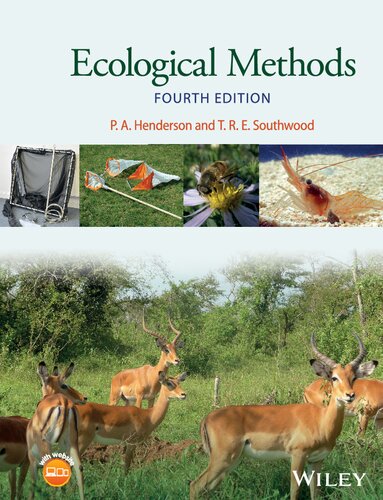

Most ebook files are in PDF format, so you can easily read them using various software such as Foxit Reader or directly on the Google Chrome browser.
Some ebook files are released by publishers in other formats such as .awz, .mobi, .epub, .fb2, etc. You may need to install specific software to read these formats on mobile/PC, such as Calibre.
Please read the tutorial at this link. https://ebooknice.com/page/post?id=faq
We offer FREE conversion to the popular formats you request; however, this may take some time. Therefore, right after payment, please email us, and we will try to provide the service as quickly as possible.
For some exceptional file formats or broken links (if any), please refrain from opening any disputes. Instead, email us first, and we will try to assist within a maximum of 6 hours.
EbookNice Team

Status:
Available4.4
23 reviews
ISBN-10 : 1118895274
ISBN-13 : 9781118895276
Author: Peter A. Henderson
Senior undergraduate students and graduate students on courses in Methods in Ecology, Ecological Methods, Computational Ecology, Experimental Design and Data Analysis in Ecology etc..
1 Introduction to the Study of Animal Populations
1.1 Population estimates
1.2 Errors and confidence
References
2 The Sampling Programme and the Measurement and Description of Dispersion
2.1 Preliminary sampling
2.2 The sampling programme
2.3 Dispersion
2.4 Sequential sampling
2.5 Presence or absence sampling
2.6 Sampling a fauna
2.7 Biological and other qualitative aspects of sampling
2.8 Jack knife and Bootstrap techniques
References
Notes
3 Absolute Population Estimates Using Capture–Recapture Experiments
3.1 Capture–recapture methods
3.2 Methods of marking animals
References
Notes
4 Absolute Population Estimates by Sampling a Unit of Habitat – Air, Plants, Plant Products and Vertebrate Hosts
4.1 Sampling from the air
4.2 Sampling apparatus
4.3 Comparison and efficiencies of the different types of suction traps
4.4 Sampling from plants
4.5 Sampling from vertebrate hosts
References
5 Absolute Population Estimates by Sampling a Unit of Aquatic Habitat
5.1 Open water
5.2 Vegetation
5.3 Bottom fauna
5.4 Poisons and anaesthetics used for sampling fish in rock pools and small ponds
References
6 Absolute Population Estimates by Sampling a Unit of Soil or Litter Habitat: Extraction Techniques
6.1 Sampling
6.2 Bulk staining
6.3 Mechanical methods of extraction
6.4 Behavioural or dynamic methods
6.5 Summary of the applicability of the methods
References
7 Relative Methods of Population Measurement and the Derivation of Absolute Estimates
7.1 Factors affecting the size of relative estimates
7.2 The uses of relative methods
7.3 Relative methods: catch per unit effort
7.4 Relative methods: trapping
7.5 Traps that attract animals by some natural stimulus or a substitute
7.6 Using Sound
References
8 Estimates of Species Richness and Population Size Based on Signs, Products and Effects
8.1 Arthropod products
8.2 Vertebrate products and effects
8.3 Effects due to an individual insect
8.4 General effects: plant damage
8.5 Determining the relationship between damage and insect populations
References
9 Wildlife Population Estimates by Census and Distance Measuring Techniques
9.1 Census methods
9.2 Point and line survey methods
9.3 Distance sampling software in R
9.4 Spatial distribution and plotless density estimators
References
10 Observational and Experimental Methods for the Estimation of Natality, Mortality and Dispersal
10.1 Natality
10.2 Mortality
10.3 Dispersal
10.4 The measurement and description of home range and territory
10.5 The rate of colonisation of a new habitat and artificial substrates
10.6 The direction of migration
References
11 The Construction, Description and Analysis of Age-specific Life-tables
11.1 Types of life-table and the budget
11.2 The construction of a budget
11.3 Analysis of stage-frequency data
11.4 The description of budgets and life-tables
11.5 The analysis of life-table data
References
12 Age-grouping, Time-specific Life-tables and Predictive Population Models
12.1 Age-grouping
12.2 Aging young by developmental stage
12.3 Aging by using structures
12.4 Time-specific life-tables and survival rates
References
13 Species Richness, Diversity and Packing
13.1 Diversity
13.2 Similarity and the comparison and classification of samples
13.3 Species packing
References
Notes
14 The Estimation of Productivity and the Construction of Energy Budgets
14.1 Estimation of standing crop
14.2 Determination of energy density
14.3 Estimation of energy flow
14.4 The measurement of production
14.5 The measurement of feeding and assimilation
14.6 Feeding and assimilation rates
14.7 The measurement of the energy loss due to respiration and metabolic process
14.8 The energy budget, efficiencies and transfer coefficients
14.9 Identification of ecological pathways using stable isotopes
14.10 Assessment of energy and time costs of strategies
References
Notes
15 Studies at Large Spatial, Temporal and Numerical Scales and the Classification of Habitats
15.1 Remote sensing data from satellites
15.2 Remote sensing using piloted and unmanned aircraft
15.3 Long-term studies
15.4 Geographical information systems
15.5 Detection of density dependence in time series
15.6 Citizen science projects
15.7 Ecosystem services
15.8 Habitat classification
list of all lgbtq identities
queer in africa
african(a) queer presence
queer in africa lgbtqi identities citizenship and activism
does queer include asexual
Tags: Ecological Methods, Peter Henderson, Methods, Ecological Methods, Computational Ecology